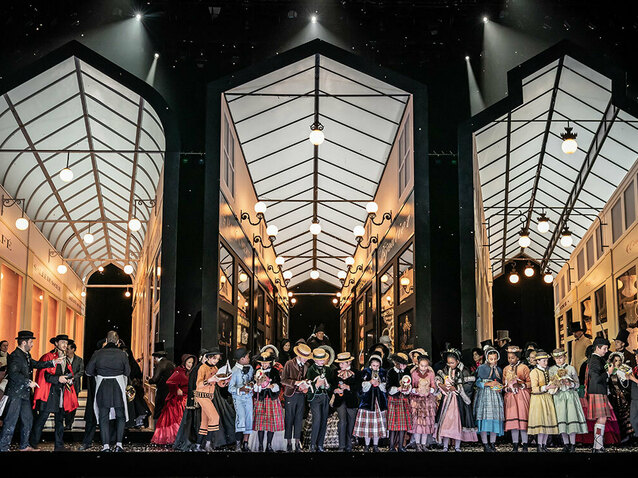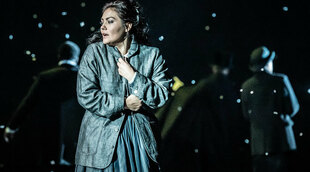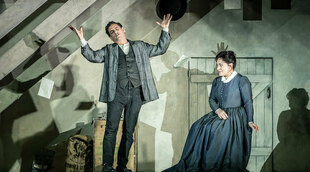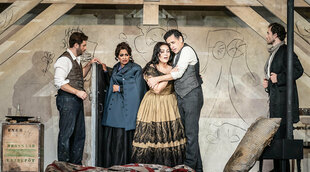 © Marc Brenner
© Marc Brenner
Giacomo Puccini’s La bohème of 1896, with a libretto by Luigi Illica and Giuseppe Giacosa, is one of the most frequently performed operas in the world today. Originally set in 1830s Paris, it focuses on six young adults and the love that four of them find with each other amidst the most impoverished of circumstances. One couple (Marcello and Musetta) have a stormy relationship but their frequent battles prove that their love actually has staying power. Rodolfo and Mimì, on the other hand, enjoy an apparently perfect love, but it is only fleeting as poverty offers no relief to Mimì and she dies of consumption.
The Royal Opera’s previous production by John Copley premiered in 1974 and continued to be revived regularly until 2015. Richard Jones’s version that replaced it in 2017 is now onto its fourth revival, including a socially distanced outing in 2021, and both are to a large extent products of their respective times. Copley pushed boundaries by injecting such high levels of realism, dynamism and detail into his production. Today, we are more inclined to warm to a less exuberant aesthetic and Jones provides a staging that combines realism with a degree of stylisation. This said, the intended tone was not there from the outset as too much hyperbole was inherent in the gestures in 2017, but these have been toned down now, meaning that the production, revived on this occasion by Danielle Urbas, has settled well.
Act I takes place in Rodolfo and Marcello’s garret, with the diagonals of the roofline really drawing the eye in. Stewart Laing’s set is also designed to suggest that the flat (and world) extends beyond the front of the stage. For example, Marcello is painting at the start but the canvas and easel are not visible because they are positioned in front of the ‘boundary line’ for the set. Similarly, Rodolfo climbs onto the roof and shouts out to the audience because his friends down below are somewhere in front of the flat and hence would be ‘in’ the auditorium.
Act II, which was written to paint a ‘Christmas card’ image of Paris, is executed beautifully as masses of people fill the streets, courtesy of movement director Sarah Fahie. Three shopping arcades are wheeled into place, which create a magical glow with their strong aesthetic and use of perspective, and crowds scurry in and out of them as they look in the shop windows. Just when one feels that nothing more could be squeezed out of these pieces they are pushed aside to introduce Café Momus. In fact, the protagonists enter it via an arcade so that as one structure is wheeled off the other is brought on. At the end of the scene, in another slick move, the box-like area is split in two to allow rows of street lights to be placed centre-stage, between which the tattoo can pass.
Not everything works perfectly still, and while in some productions one really senses the world that lies beyond the garret, that is harder to do in this instance. Despite the attempts to reveal how things extend beyond what we see, it does rather feel as if the set simply stands within the dark void of the rest of the stage. Nevertheless, as this production continues its life, it becomes easier to appreciate that it does not render everything entirely literally. Act II’s arcades can just be glimpsed in the wings during Act I, and the garret stands at the back of the stage during Act III ready to be turned around and spring into life once more when Act IV begins. Stage hands are employed to carry out several visible manoeuvres and, while they are sometimes obscured by the crowds of people, there are no overly fussy attempts to hide them. There is consequently just a touch of the Brechtian to the staging, with the result that we feel as if we are taking a glimpse into the final four acts of Mimì’s life. The approach also aids the sense of emotion so that as the tavern where Marcello and Musetta work is removed from the stage towards the end of Act III, this reveals just how alone or exposed to the elements the protagonists feel in the depths of winter.
The challenge that any production of La bohème faces is to reconcile the grittiness of the lives being portrayed with Puccini’s ethereal music by showing how such a perfect love can rise above, or indeed out of, the most impoverished circumstances. It is a challenge that this revival meets particularly well and this is attributable in large part to the excellent cast. As Juan Diego Flórez’s Rodolfo sings ‘Che gelida manina’, he swings his arms and clutches at a beam, demonstrating the type of highly believable excitement that derives from Mimì having suddenly transformed his life and raised him to a higher plane. He remains on the high C on ‘speranza’ for an enormous length of time and his gorgeous vocal performance is marked out by great consistency, so that every phrase is handed the same attention to detail and beauteous tone as the most climactic moments to the most famous parts. He is also very good at changing the mood so that as his three friends depart in Act I he suddenly looks more contemplative as he huddles in a corner and attempts to write.
Flórez’s chemistry with Ailyn Pérez’s Mimì is brilliant so that the pair’s recollection of the first time they met while she is dying in Act IV feels as believable as it is undoubtedly moving. Pérez captures equally Mimì’s frailty and spirit in both her acting and voice. Her highly secure soprano can be sumptuous but is never made to feel too overbearing for the role, as the shape of her sound and her phrasing are always immaculate.
Danielle de Niese takes the stage by storm as Musetta, with her acting being perfect whether she is petulantly playing with her cutlery as if they were people, showing a degree of nonchalance when Marcello returns to her even though she has gone all out to get him, or singing ‘Quando me’n vo’’ while walking across Café Momus’s table tops. As Marcello, Andrey Zhilikhovsky reveals an extremely persuasive baritone and his duet ‘O Mimì, tu più non torni’ with Flórez is outstanding as the two singers create sounds that work extremely well together. Ross Ramgobin also stands out for the strength of his own baritone and the flamboyance he brings to the role of the musician Schaunard, while Michael Mofidian provides an effective contrast as the philosopher Colline who generates a quieter presence and delivers an excellent performance of ‘Vecchia zimarra’. Jeremy White and Wyn Pencarreg play their parts to the full in the small roles of Benoît and Alcindoro respectively.
In the pit, Kevin John Edusei delivers a lithe account of the score that enables certain lines and instruments to come to the fore in picking up on the mood, and in some cases humour, of what is happening on stage. Conducting honours across the run are shared between Edusei, Evelino Pidò and Paul Wynne Griffiths, while most principal roles are similarly spread across three or four singers. In particular, Rodolfo is shared between Flórez, Freddie de Tommaso, David Junghoon Kim and Stefan Pop and Mimì between Pérez, Aida Garifullina and Anna Princeva. This La bohème, featuring the cast and conductor described here, will be broadcast live to selected cinemas around the world on 20 October 2022, with some venues also showing encore screenings on subsequent days.
By Sam Smith
La bohème | 14 October - 17 November 2022 | Royal Opera House, Covent Garden
the 16 of October, 2022 | Print



Comments